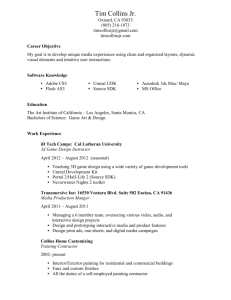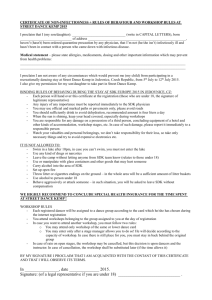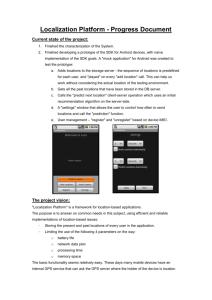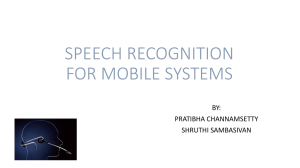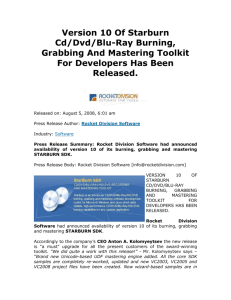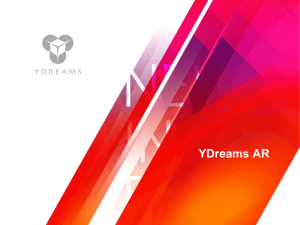BlackfinSDK-ReleaseN..
advertisement
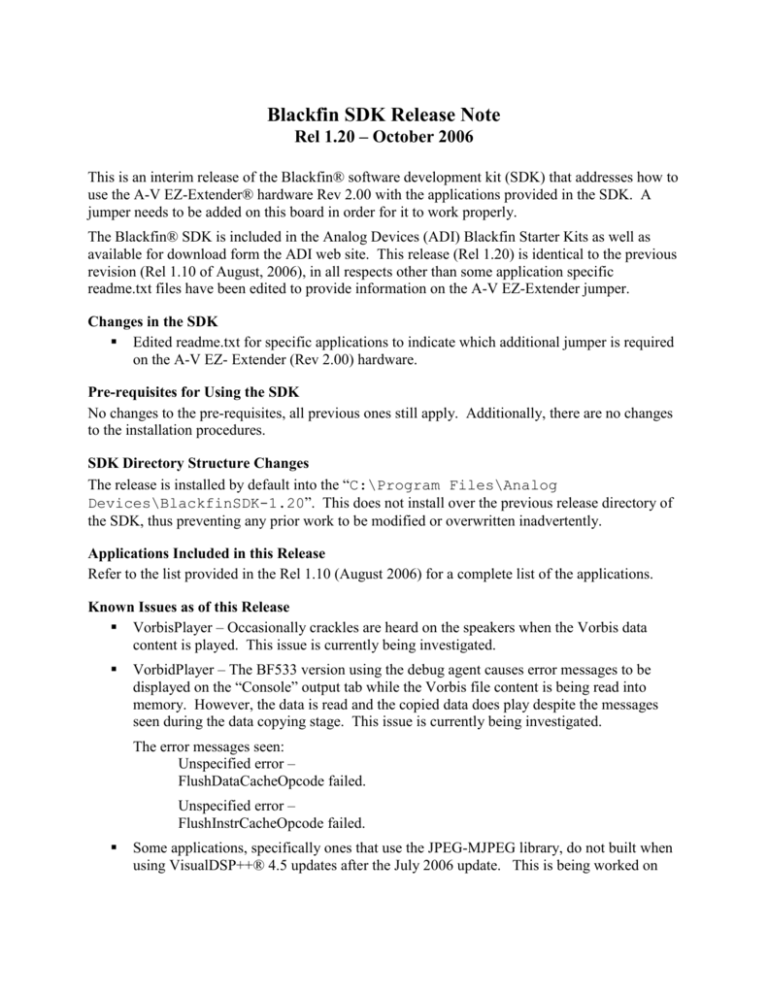
Blackfin SDK Release Note Rel 1.20 – October 2006 This is an interim release of the Blackfin® software development kit (SDK) that addresses how to use the A-V EZ-Extender® hardware Rev 2.00 with the applications provided in the SDK. A jumper needs to be added on this board in order for it to work properly. The Blackfin® SDK is included in the Analog Devices (ADI) Blackfin Starter Kits as well as available for download form the ADI web site. This release (Rel 1.20) is identical to the previous revision (Rel 1.10 of August, 2006), in all respects other than some application specific readme.txt files have been edited to provide information on the A-V EZ-Extender jumper. Changes in the SDK Edited readme.txt for specific applications to indicate which additional jumper is required on the A-V EZ- Extender (Rev 2.00) hardware. Pre-requisites for Using the SDK No changes to the pre-requisites, all previous ones still apply. Additionally, there are no changes to the installation procedures. SDK Directory Structure Changes The release is installed by default into the “C:\Program Files\Analog Devices\BlackfinSDK-1.20”. This does not install over the previous release directory of the SDK, thus preventing any prior work to be modified or overwritten inadvertently. Applications Included in this Release Refer to the list provided in the Rel 1.10 (August 2006) for a complete list of the applications. Known Issues as of this Release VorbisPlayer – Occasionally crackles are heard on the speakers when the Vorbis data content is played. This issue is currently being investigated. VorbidPlayer – The BF533 version using the debug agent causes error messages to be displayed on the “Console” output tab while the Vorbis file content is being read into memory. However, the data is read and the copied data does play despite the messages seen during the data copying stage. This issue is currently being investigated. The error messages seen: Unspecified error – FlushDataCacheOpcode failed. Unspecified error – FlushInstrCacheOpcode failed. Some applications, specifically ones that use the JPEG-MJPEG library, do not built when using VisualDSP++® 4.5 updates after the July 2006 update. This is being worked on and will be fully resolved by the next release of the SDK (Rel 2.00) which is scheduled for release in December 2006. Blackfin SDK Release Note Rel 1.10 – August 2006 This is the second release of the Blackfin® software development kit (SDK), which is included in the Analog Devices (ADI) Blackfin Starter Kits as well as available for download form the ADI web site. This revision of the SDK expands from the previous release, meaning it includes all that was previously released as well as newly added objects. Changes in the SDK Added support for the ADSP-BF533 EZ-KIT Lite® platform. This release of the SDK supports both BF561 and BF533. Added several new applications to support the BF533 and improved the previously released ones used with BF561. Refer to list of names below for a complete list of all included applications. Several application names were changed to reflect and use a more functionally descriptive name. Added several component data sheets to the documentations folder. Added documentation on the JPEG/MJPEG algorithm and on how to use it. “Multimedia” application folder name changed from “Multimedia-1.0” to “Multimedia” Added a new folder “Media” which contains all the images and motion clips used with various applications. Released a newer and more improved version of the PC host application “pc2bf.exe”, which is used with the JPEG-MJPEG application. Pre-requisites for Using the SDK No changes to the pre-requisites, all previous ones still apply. Additionally, there are no changes to the installation procedures. SDK Directory Structure Changes The release is installed by default into the “C:\Program Files\Analog Devices\BlackfinSDK-1.10”. This does not install over the previous release directory of the SDK, thus preventing any previous work to be inadvertently modified and overwritten. The folder structure mostly remains the same except that the “Multimedia” subdirectory name changed from “Multimedia-1.0” to “Multimedia”. All the application names provided in the “Multimedia” section of the SDK were changed and many more applications were added. Applications Included in this Release This release contains the following applications: Application FrameCaptureLcdOut Description Captures single frames from a video input and coverts BF533 BF561 x x Application Description BF533 BF561 them to RGB565 for display to LCD. FrameCaptureVideoOut Captures single frames from a video input and displays it on a video monitor. Supports NTSC and PAL modes. x x JPEGImageEdgeDetection Decodes JPEG file content and then displays detected edges to video display. Supports both NTSC and PAL video modes. x x JPEG-MJPEG Decodes M/JPEG files found on a PC and displays it to a video monitor. Similarly, it captures a video input, encodes it and stores in on a PC. This application was previously named “JPEGMJPEG_Demo”. x x SensorCapture Captures single frames from an attached CMOS sensor and displays to either a video monitor or an LCD display. Supports NTSC, PAL and VGA modes. x x SensorStream Captures a stream from a CMOS sensor and output it to a video monitor or VGS display. Supports NTSC, PAL and VGA modes. This also shows dynamic overlays. This application was previously named “SensorDemo”. SpeexEcho Takes in speech like stream and encodes it into Speex. It then decodes the data and plays it out to speakers. It also operates in pass through mode without encoding and decoding the input stream. This application was previously named “SpeexDemo”. x x SRGP Demonstrates a Blackfin port of the “Simple Raster Graphic Package” (SRGP). x x VideoInEdgeDetection Performs edge detection on incoming video and the displays detected edges to a video monitor. Supports NTSC and PAL display modes. This application was previously named “EdgeDetectionDemo”. x x VideoInLcdOut Video input data is converted to RGB565 and played out on an LCD monitor. Supports NTSC and PAL video input modes. x VideoInVideoOut Video data from a video capture source is rendered using a video monitor. Supports NTSC and PAL video input modes. x VorbisPlayer Decodes Vorbis encoded content and then plays it out using attached speakers. This application was previously named “VorbisDemo” x x x Known Issues as of this Release VorbisPlayer – Occasionally crackles are heard on the speakers when the Vorbis data content is played. This issue is currently being investigated. VorbidPlayer – The BF533 version using the debug agent causes error messages to be displayed on the “Console” output tab while the Vorbis file content is being read into memory. However, the data is read and the copied data does play despite the messages seen during the data copying stage. This issue is currently being investigated. The error messages seen: Unspecified error – FlushDataCacheOpcode failed. Unspecified error – FlushInstrCacheOpcode failed. Blackfin SDK Release Note Rel 1.00 – June 2006 The following release note concerns the initial release of the Blackfin Software Development Kit (SDK). This is the first of what is anticipated to be a series of releases of the SDK. The content of future SDK releases will be inclusive of all previous releases. At that time, the release noted for past releases will be appended to the end of the current release note. Pre-requisites for Using the SDK The SDK is released and only works with VisualDSP++ 4.5 and later. Any prior versions of VisualDSP++ will cause the installation of the SDK to not succeed and the provided examples and algorithms will not build successfully. Some hardware is required to run all included applications. The following is a list of ADI hardware required with this release: ADSP-BF561 EZ-KIT LITE A-V EZ-Extender USB LAN EZ-Extender Note: Although all application when built will run using the “Debug Agent” to connect to the EZKIT Lite, it is recommended that an emulator be used instead. For more information consult the VisualDSP++ 4.5 documentation and Analog Devices web site for product information. Installation Procedure: 1) Follow instructions in EZ-KIT Lite for installation of VisualDSP++ and EZ-KIT Lite 2) Install SDK CD Where SDK is Installed / Directory Structure This release of the SDK us installed by default to: “c:/Program Files/Analog Devices/BlackfinSDK”. The directory structure is as follows: Algorithms – Contains all algorithm source code and project files needed to build them. It does not include any pre-built libraries nor does it include common files needed by the applications, to link their resulting libraries. BFinUtils – Contains various utility source codes used by the installed applications and which may also be used by end user applications. Bin – Contains general PC based executables that are used to demonstrate and work with the installed applications. Include – Contains all common include files to be used by installed applications and algorithms and may also be used by the end user applications. Include files typically contain application interface function prototypes and/or external references, commonly used defines and shared variables. Lib – Contains all common libraries and algorithm pre-built binaries to be used by the installed applications and by end user applications. These libraries have both debug and release versions. Debug versions are identified by the “d” suffix in the library name. These libraries may be rebuilt using project files in the “Algorithm” folder. Multimedia-1.0 – Contains all the source code and project files required for build and executing the installed applications. Tools – Contains any special purpose binaries required for interfacing and similar action between the developer PC and the development hardware. How To Start After the SDK is successfully installed, the developer should start the VisdualDSP++4.5 development IDDE from the “Start” menu button. Once VisualDSP++ is up and running, select “File -> Open -> Project” or select “File -> Open -> Project Group” to open the desired application. Each application comes with its own “readme.txt” file which is part of the project or project group. Open the readme file for further instructions on how to do the following: 1. 2. 3. 4. Required hardware for the application How to configure the hardware How to build the application How to run the application Additionally, each readme provides an overview of the application and what it does and how it runs. Applications Included in this Release This release contains the following applications: Application Description EdgeDetectionDemo Performs edge detection on incoming video and the displays detected edges to a video monitor. JPEG-MJPEG_Demo Decodes M/JPEG files found on a PC and displays it to a video monitor. Similarly, it captures a video input, encodes it and stores in on a PC. SRGP Demonstrates a Blackfin port of the “Simple Raster Graphic Package” (SRGP). SensorDemo Takes in an image stream from a sensor and renders it to either a video monitor or a VGA LCD display. SpeexDemo Takes in speech like stream and encodes it into Speex then decodes it and plays it out to speakers. It also operated in pass through mode without encoding and decoding the input stream. VideoInLcdOut Video input data is converted to RGB565 and played out on an LCD monitor. VideoInVideoOut Video data from a video capture source is rendered using a video monitor. VorbisDemo Decodes Vorbis encoded content and then plays it out using attached speakers. Identifying Which SDK Release is Currently Installed on Your System The SDK release number is identified in a file inside the SDK installation folder “…\Tools\BlackfinSDK.ini”, in the “Version” key. Known Issues as of this Release JPEG-MJPEG_Demo – When the build configuration is switched between debug and release, the project dependencies should be updated or the project may not build in the new configuration. Refer to included readme file for more detail.
